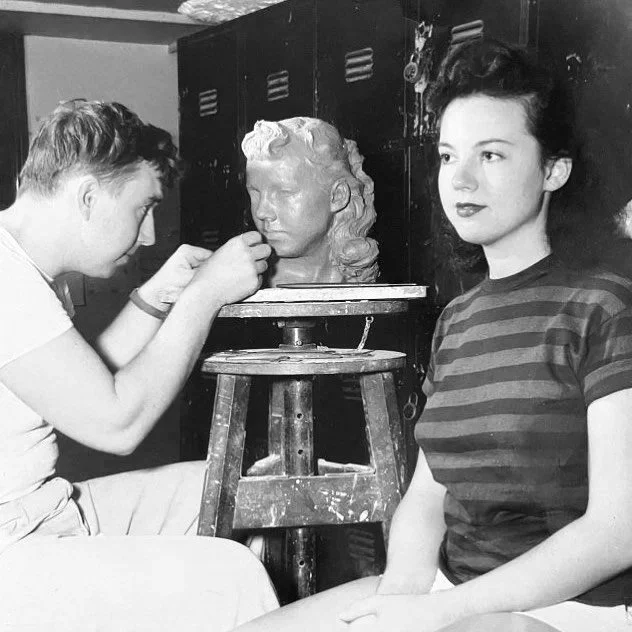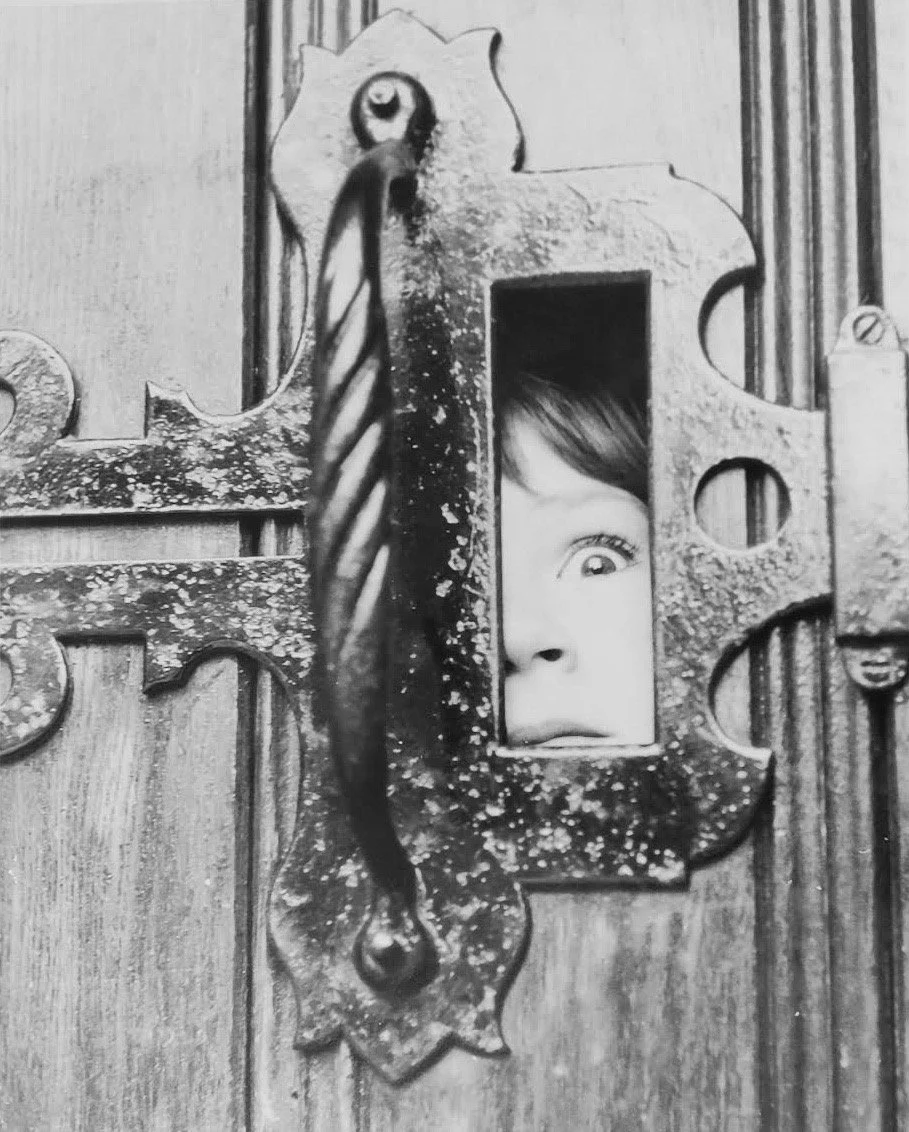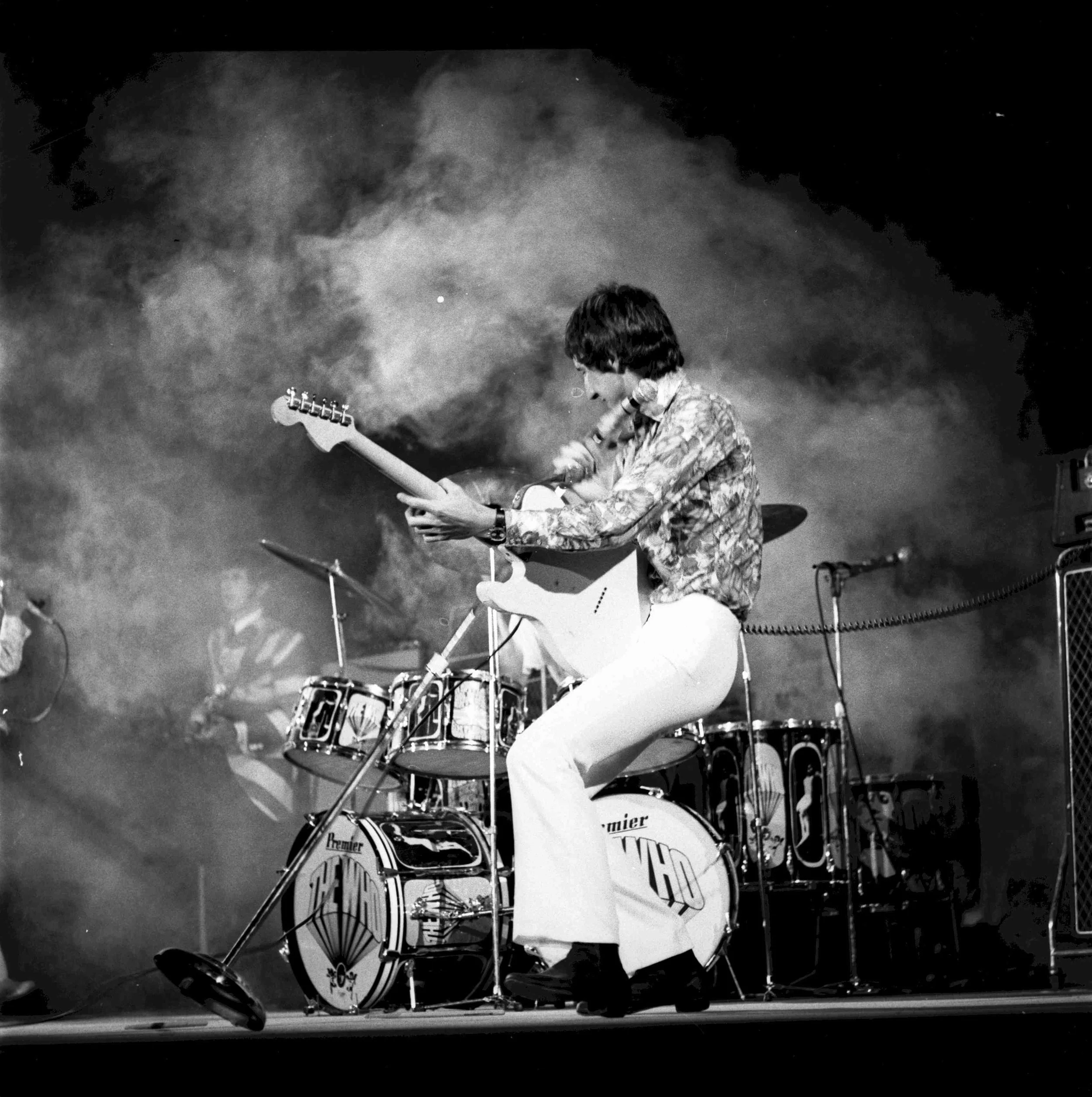Some inherit land. I inherited vision.
A soul-deep inheritance: a family story of art, spirit, and wild originality.
For those who enjoy the story behind the story — here are some of the roots and branches of my family tree that have nourished a rare and eclectic current of creativity.
From science fiction to classic rock’n’roll, from discipline to depravity to sincere devotion… from word, to image, to brush — this is the textured inheritance I carry forward.
Not a pedigree, but a pilgrimage.
Not a blueprint, but a resonance.
These are the echoes that shaped me — and the ancestors I walk with as I make my own way.
Keith Laumer
(1925–1993)
Science Fiction Author • Polymath • Visionary • Grandfather
Keith in Champaign, Illinois, circa 1951 — shaping a bronze portrait of his wife, my grandmother, Jan.
Though I was too young to know him well, my grandfather Keith Laumer has always been present — not just as a celebrated science fiction author, but as a spirit of possibility woven through the fabric of my creative life. He was a creative force whose influence runs deeper than genes — his life and legacy helped mold the souls of his family and lineage.
A former diplomat and Air Force officer turned prolific writer, Keith brought discipline and imagination into rare harmony. He made a full-time career from his mind’s eye — crafting complex, visionary worlds through influential series like Retief, about an intergalactic diplomat, and Bolo, about a sentient war machine. His novel Worlds of the Imperium, with its collision of Victorian elegance and futuristic science, is even credited by some as an early origin point of what would later be called steampunk.
Not only did he write intelligent, high-action galactic adventures, but he wove them with rare wit — savagely poking fun at the very bureaucracies he had once navigated in his diplomatic service. Game of Thrones author George R.R. Martin once remarked, “Keith Laumer was a great writer.”
And beneath the accessible tone of pulp science fiction, his work holds surprising depth. One contemporary Russian scholar has even called Dinosaur Beach “the most important book of the 20th century,” citing its timely allegory and historical insight beneath the genre surface.
His legacy is part profound scientific thinker, part playful escapist — and fully committed to the idea that creative freedom and commercial success can co-exist, and even elevate one another.
What he passed down to me is not just a name, but a deep, living permission:
To take beauty seriously.
To explore the cosmos, inner and outer.
To make a life from art — and to mean it.
There’s something space-bound and mythic in his work that quietly echoes through the lines of my mother’s paintings and into my own — an unbroken thread of inquiry, wonder, and creative devotion.
↓ Scroll for Sabrina’s story, or visit The Collection.
Sabrina Laumer
Painter • Mystic • Mother
Young Sabrina peering through the keyhole of their three-story brownstone in Ealing — captured by her brother, rock and roll photographer Tom Wright.
My mother, Sabrina Laumer, is a wild and luminous creative force — a mystic in motion, a seeker in every sense, and a woman whose art feels like living rhythm.
She was born in Rangoon, Burma, where my grandfather served in a diplomatic role at the American Embassy. Her earliest memories are braided with the smell of spice bazaars, the color of saris, and the sway of her indigenous nanny. After Burma, the family moved to west London. This gloomy atmospheric period from 1960 to 1963 left a lasting impression on Sabrina and her siblings. Their house was a rambling Edwardian on three acres, near Pitshanger Lane. They hosted a German painter for six months, providing him with art supplies and the entire third floor of their house. He was a masterful, unrecognized impressionist who worked with oil paints and homemade canvas boards. As a five-year-old, Sabrina would sit quietly and watch him paint, patiently waiting for her favorite part: a “monster ride” on his shoulders through the orchard — his false front teeth removed for effect, the dog snapping wildly at his heels in full protector mode.
Her own mother, Janice, was an Alabama beauty queen turned globe trotter and spiritual seeker, who manifested a quiet creativity through cooking, sewing, and the rhythms of daily life. That domestic ingenuity formed a powerful legacy of its own.
As she earned a degree in art, her most impactful influence came from her teenage marriage to a UT-trained expressionist painter — the frontman of the now-iconic San Antonio punk band Sons of Hercules, whose band opened for the Sex Pistols tour in 1978. That raw, electric energy — combined with her deep, truth-seeking nature — shaped her work profoundly.
Sabrina has lived many lives — studio artist at Blue Star, steward of Keith Laumer’s literary estate, and an adventurous, devoted mother. When she was only eleven, members of The Who stayed at her father’s Florida home. In a moment of rock-and-roll derangement, Keith Moon fired a rifle at her. Later that evening, contrite and draped in a tea towel like a waiter, he reappeared with a tray of food, announcing: “Cabana room service.”
Her paintings feel like maps made of memory and drumbeats — expressive, gestural, cosmic. They blend abstract expressionism, Burmese mysticism, and the rock-and-roll fire of the 1960’s and 1970s, when she and her sister Antoinette floated backstage at concerts with future legends.
Her work is in the presidential archives, and her collectors include Frost Bank as well as private and corporate patrons — but her greatest artistic legacy may be the soul environment she created for me to become the artist I am.
What she gave me wasn’t just guidance — it was a language.
Not copied, but inherited.
Not tamed, but translated.
Raw, sacred, and alive.
↓ Scroll to meet more of my creative lineage, or return to About Jacqueline.
Henry Reed
(1924–1999)
Restaurateur • Storyteller • Grandfather
My grandfather Henry, whom I called Papa, cradling a pensive baby me.
“When the neighbors stare — put on your mother’s heels and give them a show.”
My step-grandfather, Henry Reed, wasn’t an artist in the traditional sense. He was something rarer: a man who curated joy, theatricality, and delight for other people — and made a life out of doing what he loved.
After contracting polio in his youth, Henry used a wheelchair for the rest of his life — but that chair was like a throne. He was the kingliest personality in every room. A lifelong entrepreneur, he created some of San Antonio’s most memorable restaurants:
The Old San Francisco Steakhouse, a time-travel fantasy chain of 1890s “Gold Rush” opulence and elegance with live piano music and a girl on a red velvet swing
Sea Island, a beloved seafood destination chain still in operation today
Henry taught me that creativity doesn’t only live on the canvas — it lives in hospitality, in laughter, in spectacle, in how you walk (or roll) through the world.
He taught me to take life with humor and grace.
And his final words to me — a blessing I carry — were simply:
Be kind.
↓ Scroll for Tom Wright’s story, or visit My Work.
Tom Wright
(1944–2022)
Rock & Roll Photographer • Uncle
Among Tom’s most iconic images of The Who — a moment that distills the beautiful chaos and allure of his time.
If you’ve ever seen The Who at their most iconic — smashing guitars in a haze of smoke and light — chances are, you’ve seen the world through Tom Wright’s lens. But Tom wasn’t merely documenting rock history — he was helping shape it.
Thirteen years my mother’s senior, Tom was her half-brother — a cultural bridge between generations. When my grandfather was stationed in London, Tom attended Ealing Art College, where he roomed with a young Pete Townshend. It was Tom who introduced Townshend to American blues (and marijuana), two influences that helped form the very DNA of The Who. Townshend later said, “If it hadn’t been for Tom Wright, there would have been no Who.”
Tom’s eye was as unflinching as it was distinctive. He captured raw, electric, mythic moments — not as an outsider, but as someone in the room, in the van, on the stage. His images weren’t just technically brilliant; they vibrated with lived-in chaos, late-night poetry, and the cracked charisma of the rock era. As Keith Richards once put it, Tom was “an f***ing great photographer with a special touch.”
But perhaps the most lasting thing Tom passed down to us wasn’t just a body of work — it was a way of being. He taught that art isn’t something you merely observe; it’s something you live. You don’t have to be famous to be unforgettable. The stories you carry can be the ones you help create.
He photographed me the day I was born — the first eye to frame me, my first encounter with art just hours into this life. His presence in our family was larger-than-life: cynical, hilarious, self-deprecating, and deeply embedded in the mythos of our creative lineage.
His legacy is tangled and bright. He widened the world for his sisters, cracked it open for the rest of us, and left behind not just photographs — but a blueprint for living as part of the art itself.
Through him, I carry a connection to the charged space between rebellion and image — the power of framing a fleeting moment so it lives on.
↓ Continue for more creative lineage, or return to About Jacqueline.
Creative Atmosphere
(The Water We Swam In)
In my family, art wasn’t a distant dream — it lived in the next room, the garage, the stage, the story at dinner. Fame, too, was never the goal, but it hovered just a breath away — not as glamour, but as proximity. It made the idea of a creative life feel not only possible, but normal.
One of my mother’s older sisters, Antoinette, was a seamstress for classic rock bands and later, films. She created for Freddie Mercury and countless others, stitching glamour and grit into every piece. Her second husband was drummer Hunt Sales, son of comedian Soupy Sales and drummer for Iggy Pop (yes, that’s him on Lust for Life) and later a bandmate of David Bowie in Tin Machine. Bowie was my cousin’s godfather — not someone I ever knew personally, but someone who felt near, like so many others in that sparkling constellation.
The point isn’t name-dropping — it’s atmosphere. These stories weren’t bragged about; they were just part of the fabric. Art, at its highest and most iconic and unconventional levels, lived close.
It didn’t necessarily make anyone rich. It didn’t always make them happy. But it made a life in art real. And it quietly taught me something vital:
You don’t have to wait for permission.
You just begin.
— Jacqueline



